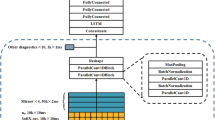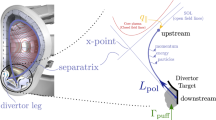Abstract
In nuclear fusion reactors, plasmas are heated to very high temperatures of more than 100 million kelvin and, in so-called tokamaks, they are confined by magnetic fields in the shape of a torus. Light nuclei, such as deuterium and tritium, undergo a fusion reaction that releases energy, making fusion a promising option for a sustainable and clean energy source. Tokamak plasmas, however, are prone to disruptions as a result of a sudden collapse of the system terminating the fusion reactions. As disruptions lead to an abrupt loss of confinement, they can cause irreversible damage to present-day fusion devices and are expected to have a more devastating effect in future devices. Disruptions expected in the next-generation tokamak, ITER, for example, could cause electromagnetic forces larger than the weight of an Airbus A380. Furthermore, the thermal loads in such an event could exceed the melting threshold of the most resistant state-of-the-art materials by more than an order of magnitude. To prevent disruptions or at least mitigate their detrimental effects, empirical models obtained with artificial intelligence methods, of which an overview is given here, are commonly employed to predict their occurrence—and ideally give enough time to introduce counteracting measures.
This is a preview of subscription content, access via your institution
Access options
Access Nature and 54 other Nature Portfolio journals
Get Nature+, our best-value online-access subscription
$29.99 / 30 days
cancel any time
Subscribe to this journal
Receive 12 print issues and online access
$209.00 per year
only $17.42 per issue
Buy this article
- Purchase on Springer Link
- Instant access to full article PDF
Prices may be subject to local taxes which are calculated during checkout




Similar content being viewed by others
References
Boozer, A. H. Theory of tokamak disruptions. Phys. Plasmas 19, 058101 (2012).
de Vries, P. C. et al. Requirements for triggering the ITER disruption mitigation system. Fusion Sci. Technol. 69, 471–484 (2016).
Wenninger, R. et al. Power handling and plasma protection aspects that affect the design of the DEMO divertor and first wall. In Proc. 26th IAEA Fusion Energy Conference (FEC, 2018); https://nucleus.iaea.org/sites/fusionportal/Shared%20Documents/FEC%202016/fec2016-preprints/preprint0322.pdf
Sozzi, C. et al. Termination of discharges in high performance scenarios in JET. In Proc. 28th IAEA Fusion Energy Conference (FEC, 2020); https://conferences.iaea.org/event/214/contributions/17328/
Strait, E. J. et al. Progress in disruption prevention for ITER. Nucl. Fusion 59, 112012 (2019).
Hollmann, E. M. et al. Status of research toward the ITER disruption mitigation system. Phys. Plasmas 22, 021802 (2015).
Esposito, B. et al. Disruption avoidance in the Frascati tokamak upgrade by means of magnetohydrodynamic mode stabilization using electron-cyclotron-resonance heating. Phys. Rev. Lett. 100, 045006 (2008).
Maraschek, M. et al. Path-oriented early reaction to approaching disruptions in ASDEX upgrade and TCV in view of the future needs for ITER and DEMO. Plasma Phys. Control. Fusion 60, 014047 (2017).
Baylor, L. R. et al. Disruption mitigation system developments and design for ITER. Fusion Sci. Technol. 68, 211–215 (2015).
Pautasso, G. et al. On-line prediction and mitigation of disruptions in ASDEX upgrade. Nucl. Fusion 42, 100–109 (2002).
Cannas, B., Fanni, A., Pautasso, G., Sias, G. & Sonato, P. An adaptive real-time disruption predictor for ASDEX Upgrade. Nucl. Fusion 50, 075004 (2010).
Kates-Harbeck, J., Svyatkovskiy, A. & Tang, W. Predicting disruptive instabilities in controlled fusion plasmas through deep learning. Nature 568, 526–531 (2019).
Churchill, R. M. et al. Deep convolutional neural networks for multi-scale time-series classification and application to tokamak disruption prediction using raw, high temporal resolution diagnostic data. Phys. Plasmas 27, 062510 (2020).
Akçay, Cihan et al. Machine learning methods for probabilistic locked-mode predictors in tokamak plasmas. Phys. Plasmas 28, 082106 (2021).
Ferreira, D. R., Carvalho, P. J. & Fernandes, H. Deep learning for plasma tomography and disruption prediction from bolometer data. IEEE Trans. Plasma Sci. 48, 36–45 (2019).
Rattá, G. A. et al. An advanced disruption predictor for JET tested in a simulated real-time environment. Nucl. Fusion 50, 025005 (2010).
Vega, J. et al. Results of the JET real-time disruption predictor in the ITER-like wall campaigns. Fusion Eng. Des. 88, 1228–1231 (2013).
Dormido-Canto, S. et al. Development of an efficient real-time disruption predictor from scratch on JET and implications for ITER. Nucl. Fusion 53, 113001 (2013).
Vega, J. et al. Adaptive high learning rate probabilistic disruption predictors from scratch for the next generation of tokamaks. Nucl. Fusion 54, 123001 (2014).
Agarwal, A. et al. Deep sequence to sequence learning-based prediction of major disruptions in ADITYA tokamak. Plasma Phys. Control. Fusion 63, 115004 (2021).
Zhang, Y., Pautasso, G., Kardaun, O., Tardini, G. & Zhang, X. D. Prediction of disruptions on ASDEX Upgrade using discriminant analysis. Nucl. Fusion 51, 063039 (2011).
Rea, C. et al. Disruption prediction investigations using machine learning tools on DIII-D and Alcator C-Mod. Plasma Phys. Control. Fusion 60, 084004 (2018).
Rea, C., Montes, K. J., Erickson, K. G., Granetz, R. S. & Tinguely, R. A. A real-time machine learning-based disruption predictor in DIII-D. Nucl. Fusion 59, 096016 (2019).
Rea, C. & Granetz, R. S. Exploratory machine learning studies for disruption prediction using large databases on DIII-D. Fusion Sci. Technol. 74, 89–100 (2018).
Zheng, W. et al. Disruption predictor based on neural network and anomaly detection on J-TEXT. Plasma Phys. Control. Fusion 62, 045012 (2020).
Gerhardt, S. P. et al. Detection of disruptions in the high-β spherical torus NSTX. Nucl. Fusion 53, 063021 (2013).
Montes, K. J. et al. Machine learning for disruption warnings on Alcator C-Mod, DIII-D and EAST. Nucl. Fusion 59, 096015 (2019).
Yokoyama, T. et al. Likelihood identification of high-β disruption in JT-60U. Plasma Fusion Res. 16, 1402073 (2021).
Guo, B. H. et al. Disruption prediction on EAST tokamak using a deep learning algorithm. Plasma Phys. Control. Fusion 63, 115007 (2021).
Guo, B. H. et al. Disruption prediction using a full convolutional neural network on EAST. Plasma Phys. Control. Fusion 63, 025008 (2020).
Hu, W. H. et al. Real-time prediction of high-density EAST disruptions using random forest. Nucl. Fusion 61, 066034 (2021).
Zhong, Y. et al. Disruption prediction and model analysis using LightGBM on J-TEXT and HL-2A. Plasma Phys. Control. Fusion 63, 075008 (2021).
Moreno, R. et al. Robustness and increased time resolution of JET Advanced Predictor of Disruptions. Plasma Phys. Control. Fusion 56, 114003 (2014).
Murari, A. et al. Adaptive predictors based on probabilistic SVM for real-time disruption mitigation on JET. Nucl. Fusion 58, 056002 (2018).
López, J. M. et al. Implementation of the disruption predictor APODIS in JET’s real-time network using the MARTe framework. IEEE Trans. Nucl. Sci. 61, 741–744 (2014).
Esquembri, S. et al. Real-time implementation in JET of the SPAD disruption predictor using MARTe. IEEE Trans. Nucl. Sci. 65, 836–842 (2018).
Vega, J. et al. A linear equation based on signal increments to predict disruptive behaviours and the time to disruption on JET. Nucl. Fusion 60, 026001 (2019).
Rea, C. et al. Progress toward interpretable machine learning-based disruption predictors across tokamaks. Fusion Sci. Technol. 76, 912–924 (2020).
Zhu, J. X. et al. Hybrid deep-learning architecture for general disruption prediction across multiple tokamaks. Nucl. Fusion 61, 026007 (2020).
Zhu, J. et al. Scenario adaptive disruption prediction study for next generation burning-plasma tokamaks. Nucl. Fusion 61, 114005 (2021).
Murari, A., Lungaroni, M., Gelfusa, M., Peluso, E. & Vega, J. JET Contributors Adaptive learning for disruption prediction in non-stationary conditions. Nucl. Fusion 59, 086037 (2019).
Murari, A. et al. On the transfer of adaptive predictors between different devices for both mitigation and prevention of disruptions. Nucl. Fusion 60, 056003 (2020).
Murari, A., Rossi, R., Lungaroni, M., Baruzzo, M. & Gelfusa, M. Stacking of predictors for the automatic classification of disruption types to optimize the control logic. Nucl. Fusion 61, 036027 (2021).
Gunning, D. et al. XAI-explainable artificial intelligence. Sci. Robot. 4, eaay7120 (2019).
Yokoyama, T. et al. Prediction of high-beta disruptions in JT-60U based on sparse modeling using exhaustive search. Fusion Eng. Des. 140, 67–80 (2019).
Piccione, A. et al. Physics-guided machine learning approaches to predict the ideal stability properties of fusion plasmas. Nucl. Fusion 60, 046033 (2020).
Li, H. X., Yang, J. L., Zhang, G. & Fan, B. Probabilistic support vector machines for classification of noise affected data. Inf. Sci. 221, 60–71 (2013).
Rattá, G. A., Vega, J. & Murari, A., JET-EFDA Contributors. Improved feature selection based on genetic algorithms for real-time disruption prediction on JET. Fusion Eng. Des. 87, 1670–1678 (2012).
Murari, A. et al. Investigating the physics of tokamak global stability with interpretable machine learning tools. Appl. Sci. 10, 6683 (2020).
Fu, Y. et al. Machine learning control for disruption and tearing mode avoidance. Phys. Plasmas 27, 022501 (2020).
Boyer, M. D., Rea, C. & Clement, M. D. Toward active disruption avoidance via real-time estimation of the safe operating region and disruption proximity in tokamaks. Nucl. Fusion 62, 026005 (2021).
Rattá, G. A., Vega, J., Murari, A. & Gadariya, D., JET Contributors. PHAD: a phase-oriented disruption prediction strategy for avoidance, prevention and mitigation in JET. Nucl. Fusion 61, 116055 (2021).
Rossi, R., Gelfusa, M., Malizia, A. & Gaudio, P. Adaptive quasi-unsupervised detection of smoke plume by LIDAR. Sensors 20, 6602 (2020).
Murari, A., Peluso, E., Gelfusa, M., Lungaroni, M. & Gaudio, P. How to handle error bars in symbolic regression for data mining in scientific applications. In Proc. Third International Symposium on Statistical Learning and Data Sciences, Statistical Learning and Data Sciences. SLDS 2015. Lecture Notes in Computer Science Vol. 9047 (eds Gammerman, A. et al.) 347–355 (Springer, 2015).
Gelfusa, M. et al. UMEL: a new regression tool to identify measurement peaks in LIDAR/DIAL systems for environmental physics applications. Rev. Sci. Instrum. 85, 063112 (2014).
Acknowledgements
This work was partially funded by the Spanish Ministry of Science and Innovation under projects nos. PID2019-108377RB-C31 and PID2019-108377RB-C32. This work has been carried out within the framework of the EUROfusion Consortium, funded by the European Union via the Euratom Research and Training Programme (grant agreement no. 101052200 — EUROfusion). Views and opinions expressed are however those of the authors only and do not necessarily reflect those of the European Union or the European Commission. Neither the European Union nor the European Commission can be held responsible for them.
Author information
Authors and Affiliations
Consortia
Corresponding author
Ethics declarations
Competing interests
The authors declare no competing interests.
Peer review
Peer review information
Nature Physics thanks Cristina Rea and the other, anonymous, reviewer(s) for their contribution to the peer review of this work.
Additional information
Publisher’s note Springer Nature remains neutral with regard to jurisdictional claims in published maps and institutional affiliations.
Rights and permissions
About this article
Cite this article
Vega, J., Murari, A., Dormido-Canto, S. et al. Disruption prediction with artificial intelligence techniques in tokamak plasmas. Nat. Phys. 18, 741–750 (2022). https://doi.org/10.1038/s41567-022-01602-2
Received:
Accepted:
Published:
Issue Date:
DOI: https://doi.org/10.1038/s41567-022-01602-2
This article is cited by
-
Tailoring tokamak error fields to control plasma instabilities and transport
Nature Communications (2024)
-
Avoiding fusion plasma tearing instability with deep reinforcement learning
Nature (2024)
-
Causality Detection and Quantification by Ensembles of Time Delay Neural Networks for Application to Nuclear Fusion Reactors
Journal of Fusion Energy (2024)
-
A control oriented strategy of disruption prediction to avoid the configuration collapse of tokamak reactors
Nature Communications (2024)
-
Initial analytical theory of plasma disruption and experimental evidence
Scientific Reports (2023)



